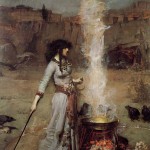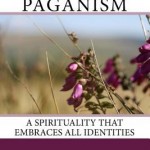There is a tendency among the spiritual-but-not-religious to regard religions as crusty old traditions that are hidebound, not evolving, and to contrast them with the spiritual people, who are free spirits who can pick and mix from the smorgasbord of religious offerings to create their own unique menu of tasty spiritual tidbits. Whereas what they are most likely to create, without some sort of roadmap, is a big ball of mud.

I saw this particularly irritating quote from Deepak Chopra the other day:
Religion is belief in someone else’s experience. Spirituality is having your own experience.
There is plenty of scope for individual spiritual experience in most religions, even in the ones we think of as quite conservative. You can have your own experience in religion – and the difference is that there will be a framework and a context and a mythology to help make sense of it and give it meaning, and a community of others who have had similar experiences to discuss it with, and to reassure you that you are not alone with your experience of the numinous.
It is all too easy to assume that all religions are merely cultural encrustations upon the “pure” mystic insight. There is a discourse that claims that there is a “pure” form of religion that could be identified if only once could scrape off the encrustations and accretions of culture, and get to the flawless diamond underneath. But this is a flawed analogy, because religions are not diamonds.
Religions are organic, they grow with and in culture – and if people rip the ideas out of context, they lose meaning and coherence. Religions are like languages – deeply embedded in culture and history; sometimes they have their own culture. Even religions that claim to be universally applicable arose at a particular time and place because of specific theological, philosophical, and spiritual concerns. Perhaps their parent religion was getting too bogged down in a particular concern, and a visionary group or individual started a new wave of ideas – sometimes this this resulted in a new religion, sometimes it resulted in a reformation of an existing one. Perhaps one day, people will look back at the early 21st century and say, that’s when Polytheism broke away from Paganism. Or perhaps they will refer to it as the Polytheist Reformation… who knows?
Religions are not all saying the same thing – they come from different philosophical and theological and cultural perspectives that cannot be reconciled without doing violence to the ideas and practices and rituals. An excellent analogy is regional cuisines – they have a set of tried and trusted recipes and techniques, using the spices and other ingredients that grow in their local area. Sometimes an exciting new ingredient arrives and transforms the cuisine (as happened when the potato arrived in England, or the chilli arrived in India). Sometimes a new cultural group arrives and brings with it a new recipe, that then gets prepared in the style of the local cuisine – did you know that the idea of fish and chips was brought to England by Sephardic Jews from Portugal? Or, some say, Huguenot refugees from France. Or that pasta was possibly brought back to Italy by Marco Polo after eating noodles in China? But the new dish gets brought within the repertoire of the existing cuisine, and altered to suit the tastes of the locals. The same thing happens with spiritual ideas and techniques – they inevitably take on the flavour of the religion into which they have been imported.
Different people have different preferences for ritual styles – that is why there are so many different styles on offer within religious traditions. There are those who prefer ecstatic ritual with dancing, those who prefer formal liturgical ritual, those who prefer spontaneity, and those who prefer their emotions to be engaged. The excellent Bill Darlison, Unitarian minister and astrologer, says that these worship styles correspond to the four elements, Earth, Air, Fire, and Water. When I heard him give this talk, he suggested that Pagans are “earthy” but I pointed out that there are as many different preferences for ritual style among Pagans as there are among Unitarians, probably more. Different traditions offer different ritual styles – Druidry has a distinctive style, Wicca has another style, Heathenry another, Religio Romana another, African Traditional Religion is different again, and so on. There are variations between groups in the various traditions too. Some people find Wicca too intense; others find it a bit tame. I think it is just right – for me.
Different people have different tastes in music – some like heavy metal, some like Gregorian chant, some like reggae, funk, and soul, others like ambient New Agey electronica. (Fortunately, no-one has yet suggested that all musical styles should be munged together into one.) Different musical styles suit different moods too; and the same applies to ritual. Sometimes I am in the mood for the ritual equivalent of Gregorian chant; other times I want something ecstatic and dancey. If we munge everything together, we lose that diversity.
And if everyone goes off on an entirely individual path, with a mixture of influences from many different traditions, how will we ever create a shared web of meaning for communicating about our experiences? As John Beckett says in an excellent blogpost, 5 Reasons You Can’t Find the Right Spiritual Path, we need a certain depth of engagement and immersion to really understand and fully experience a tradition. As I wrote in a previous post:
[A] group name expresses a distinctive identity, philosophy, tradition, set of values, mythology, and community identity. These traditions are ways of being in the world. They are collective projects which explore the question of “How shall we live a good life?” (and what do we mean by ‘a good life’) in very different ways. They each have their own rich collection of source texts and rituals which try to answer that basic question, along with many of the other great existential questions, such as “Why are we here?”
When I was a little kid, I once mixed a lot of different colours of Plasticine (similar to Play-Doh) together. At first, they made a pleasing rainbow of colour – but the more they were mixed together, the more they merged into a rather disappointing olive-brown colour, until eventually there were no distinct colours, only the drab uniform olive-brown. People often think that if you mix religious traditions together, you will get the pure white light of the original ur-religion (if that ever existed). But quite often, you get brown putty instead. Of course, if you carefully mix two colours, you might get a lovely new colour. But the more colours you mix, the more likely you are to get drab olive-brown…
There is also a dangerous assumption mixed in with the idea that religions are reducible to each other: the assumption that there really is one universal religion that would suit everyone perfectly if only they let go of their adherence to their specific tradition. It is a dangerous idea because its adherents want to erase the boundaries of culture, tradition, and to eliminate diversity. They claim that it’s a very liberal idea, but actually it isn’t because it involves the imposition of ideas, a loss of context, massive cultural appropriation, and a loss of a sense of something to grapple with.
Those who advocate for pick and mix spirituality as opposed to religion fail to appreciate that tradition is organic and evolving. There is plenty of room for experimentation and innovation in most religious traditions. Sometimes the more conservative adherents resist these changes, especially if they involve LGBT people, but nevertheless religions do evolve and change.
Each religious tradition, and its various sub-traditions, has an unique and diverse perspective on the world. They have unique rituals and practices, which add to their interest and significance. These rituals often do not make sense outside of the context of the particular tradition in which they arose. Of course, there are some generic spiritual practices which can be exported from one religion to another, but I would argue they take on different meanings in their new context.
Religions are communities of people with a shared perspective, shared stories, and shared rituals. Sometimes religions can be oppressive and fanatical, but that is not the whole picture. The millions of peaceful, decent religious adherents – who are decent not in spite of their religion, but because that is how they practice their religion – deserve better than to be dismissed as hidebound traditionalists and bigots.
















